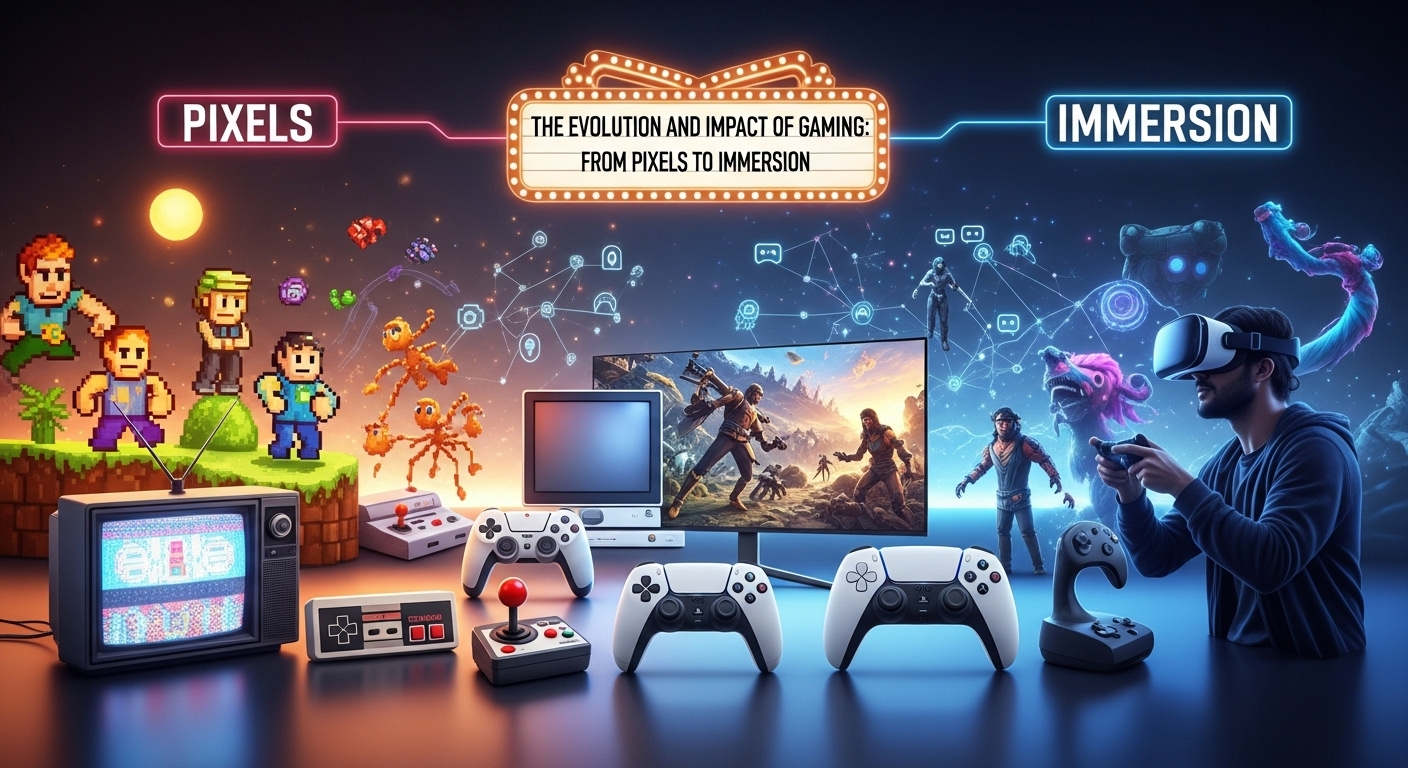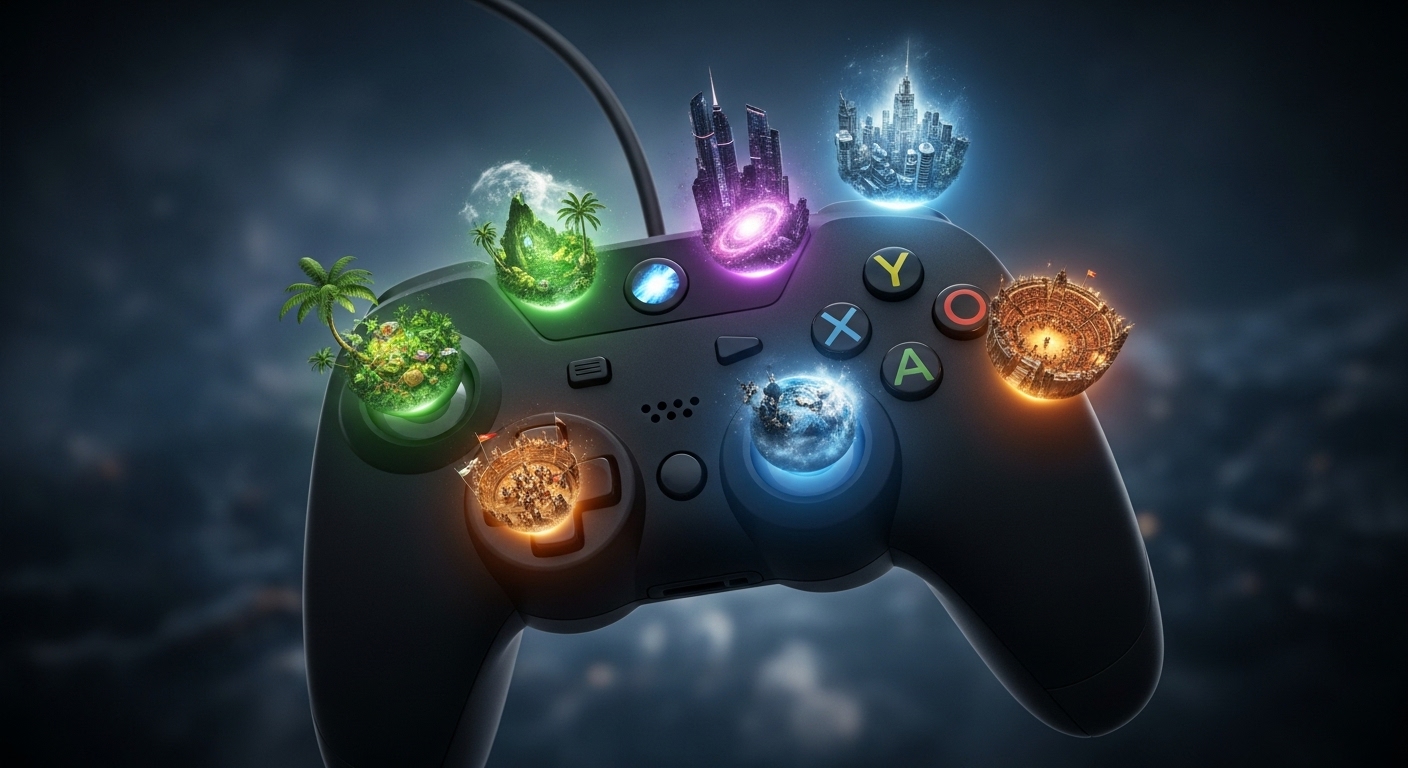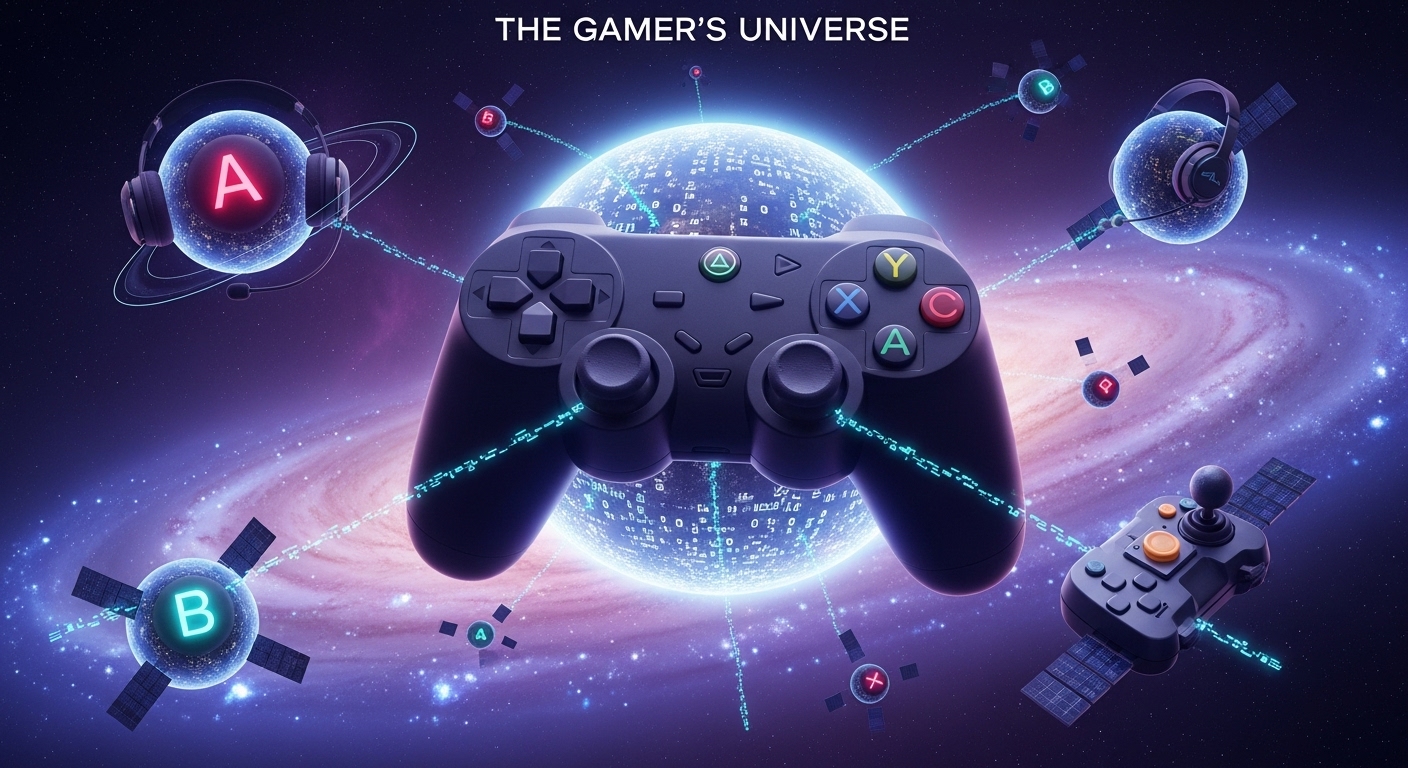Introduction: The Power of Play
Gaming has become more than just a hobby; it is a form of art, expression, competition, and storytelling that transcends age, geography, and language. What began as simple experiments in interactive entertainment has evolved into a multi-billion-dollar industry shaping technology, culture, and even human connection. Gaming is not merely about pressing buttons or staring at screens. It is about creativity, strategy, community, and imagination. From the earliest arcade machines to the vast open worlds of modern consoles and PCs, gaming has undergone an incredible transformation. It reflects human innovation at its best, combining design, music, storytelling, and technology into one interactive experience.
The Birth of Gaming: A Digital Revolution Begins
The roots of gaming trace back to the mid-20th century, when computers were massive machines confined to universities and laboratories. The earliest known game, “Tennis for Two,” created in 1958 by physicist William Higinbotham, was a simple tennis simulation displayed on an oscilloscope. A few years later, in 1962, “Spacewar!” was born at MIT, becoming the first digital computer game to gain significant popularity among programmers. These early games were primitive by modern standards, yet they laid the foundation for everything that followed. The 1970s brought gaming to the public through arcades and home consoles. The release of “Pong” in 1972 marked the commercial birth of video games. Developed by Atari, “Pong” captured the imagination of millions. Suddenly, entertainment was interactive, competitive, and available to everyone.
The Arcade Era: Where Legends Were Born
The late 1970s and 1980s were the golden age of arcade gaming. Colorful cabinets filled with beeping machines lined the walls of malls, restaurants, and entertainment centers. Games like “Pac-Man,” “Space Invaders,” “Donkey Kong,” and “Galaga” became cultural icons. The arcade became a place of social gathering, where players tested their reflexes, memorized patterns, and competed for high scores. Every flashing light and pixelated sprite was a step toward a future where digital entertainment would dominate. Arcades also created the first gaming celebrities. Players who mastered the toughest games or achieved record-breaking scores became local legends. The idea of competition and skill in gaming began here, evolving later into the global esports scene we know today.
The Rise of Home Consoles
As technology advanced, the dream of playing video games at home became a reality. In the late 1970s, consoles like the Atari 2600 brought gaming from arcades into living rooms. For the first time, families could enjoy digital entertainment together. The 1980s saw fierce competition among companies like Nintendo, Sega, and Atari. Nintendo’s release of the Nintendo Entertainment System (NES) in 1985 revitalized the industry after a brief crash. With timeless titles like “Super Mario Bros.,” “The Legend of Zelda,” and “Metroid,” Nintendo didn’t just sell games; it created universes. The NES era shaped generations of gamers and introduced iconic characters still loved today.
The 16-Bit Revolution
By the early 1990s, the console wars intensified. The 16-bit battle between the Super Nintendo Entertainment System (SNES) and the Sega Genesis defined the decade. Gaming became faster, richer, and more competitive. Each company pushed the limits of technology, showcasing better graphics, sound, and gameplay. This was an era of innovation where storytelling began to merge with action. Titles like “Final Fantasy VI,” “Chrono Trigger,” and “Sonic the Hedgehog” captured imaginations worldwide. It was also during this period that gaming music began to evolve into an art form. Memorable soundtracks, composed within the limitations of hardware, became as iconic as the games themselves.
The Birth of 3D and the PlayStation Era
When the mid-1990s arrived, gaming entered a new dimension—literally. The rise of 3D graphics transformed the medium forever. Sony’s PlayStation, Nintendo 64, and Sega Saturn introduced gamers to a new level of realism and immersion. For the first time, players could explore fully realized three-dimensional environments. Titles like “Super Mario 64,” “Tomb Raider,” and “Final Fantasy VII” changed what games could be. They were not just about scoring points; they told stories, evoked emotions, and transported players into living worlds. Gaming also began to appeal to older audiences. Mature storytelling, cinematic cutscenes, and complex characters blurred the line between movies and games. This evolution established gaming as a legitimate form of art and narrative.
The Online Revolution
The late 1990s and early 2000s introduced another transformative leap—online gaming. With the rise of the internet, players were no longer limited to competing with friends in the same room. They could now challenge opponents across the world. Multiplayer games like “Counter-Strike,” “StarCraft,” and “EverQuest” brought people together in virtual spaces. Friendships were forged, rivalries formed, and communities blossomed. The concept of “massively multiplayer online games” (MMOs) became a phenomenon. Titles like “World of Warcraft” captivated millions, offering vast worlds where players could live alternate lives, form alliances, and experience adventures together. Online gaming changed how people viewed social interaction in the digital age. It proved that games were not isolating; they were profoundly social.
The Rise of Mobile and Casual Gaming
The next major shift came with the rise of smartphones. Mobile gaming democratized the experience even further, allowing anyone with a phone to become a gamer. Simple yet addictive titles like “Angry Birds,” “Candy Crush,” and “Clash of Clans” reached audiences that had never touched a console or PC. Gaming was no longer confined to a niche group—it became a universal pastime. The success of mobile games also highlighted the importance of accessibility and design simplicity. Games did not need massive budgets or cinematic graphics to succeed. They just needed to be fun. The mobile revolution also paved the way for new monetization models, including free-to-play systems and in-app purchases, which reshaped the economics of the industry.
Esports: When Gaming Became a Global Sport
What once began as casual competition in arcades evolved into one of the largest entertainment industries in the world: esports. Competitive gaming exploded in popularity in the 2010s, with professional players, teams, and tournaments attracting millions of viewers. Games like “League of Legends,” “Dota 2,” “Counter-Strike: Global Offensive,” and “Fortnite” turned skilled gamers into international superstars. Esports events filled stadiums, and online broadcasts reached millions more. Prize pools grew to rival traditional sports tournaments. The skill, strategy, and teamwork required in these games demanded respect. Gaming had officially become a sport—a mental and mechanical challenge that demanded discipline, training, and creativity.
The Artistic Side of Gaming
Beyond competition and technology, gaming is a profound artistic medium. Modern video games rival films in visual quality and emotional depth. Developers use lighting, sound design, and narrative to craft experiences that stay with players long after the credits roll. Games like “Journey,” “The Last of Us,” and “Red Dead Redemption 2” are not just interactive entertainment—they are emotional journeys. They explore themes of love, loss, identity, and survival. Indie developers, with limited resources but boundless creativity, have also contributed immensely to gaming’s artistic growth. Games such as “Undertale,” “Hollow Knight,” and “Celeste” prove that storytelling and emotion can transcend graphics and budget.
The Role of Technology in Shaping Modern Gaming
Every leap in gaming history has been driven by technology. The rise of high-speed internet, advanced graphics processing, and powerful hardware has turned imagination into reality. Virtual reality (VR) and augmented reality (AR) now immerse players in worlds that respond to their movements and choices. Cloud gaming services have begun removing hardware barriers, allowing players to stream high-end games from any device. Artificial intelligence is shaping smarter enemies, dynamic worlds, and even procedural storytelling. With ray tracing and 4K resolution, visual fidelity continues to approach cinematic realism. Yet, the true innovation lies not only in graphics but in interactivity—the ability to shape a world through choice and consequence.
The Social Impact of Gaming
Gaming is no longer a solitary experience. It connects people across borders, languages, and generations. Online communities and cooperative games encourage teamwork, communication, and empathy. Many lifelong friendships and even marriages have begun through gaming platforms. Gaming has also become a platform for education, therapy, and social change. Educational games teach complex concepts through play, while therapeutic games help patients cope with anxiety or trauma. Developers increasingly use their platforms to address real-world issues such as climate change, mental health, and discrimination. In doing so, gaming continues to redefine its purpose in society—not just to entertain but to inspire and inform.
The Rise of Streaming and Content Creation
The advent of streaming platforms has created a new era of gaming culture. Millions of people watch others play games daily. Platforms that allow creators to share live gameplay, commentary, and reactions have turned gaming into a form of performance art. Streamers and content creators have built massive audiences and careers by entertaining others through their personality and skill. Gaming has become a shared spectacle, blurring the line between player and viewer. This shift has also amplified diversity and representation, giving rise to creators from all walks of life who share their unique perspectives on gaming.
The Business and Industry of Gaming
Gaming has grown into one of the largest industries in the world, surpassing movies and music combined. Major companies invest billions in game development, marketing, and distribution. Yet, the industry’s success also raises important questions about labor, creativity, and ethics. Game developers face intense pressure and long hours to meet deadlines, leading to discussions about workplace culture and sustainability. Meanwhile, debates about microtransactions, loot boxes, and player data privacy continue to shape the conversation about the future of gaming. Despite challenges, the industry continues to thrive, powered by passionate creators and devoted players.
The Future of Gaming: Infinite Possibilities
The future of gaming is boundless. Advances in artificial intelligence, quantum computing, and immersive technology will continue to blur the line between the real and the virtual. We may soon experience games that adapt entirely to our emotions, decisions, and personalities. The rise of the metaverse concept suggests a future where gaming and daily life may merge into shared virtual spaces. Players could live, work, and socialize in interconnected worlds that transcend current limitations. Yet, even as technology evolves, the essence of gaming will remain the same—the joy of play, the thrill of challenge, and the power of imagination.
The Cultural Legacy of Gaming
Gaming is more than technology or entertainment; it is a cultural language. References to games appear in films, art, fashion, and music. Classic characters like Mario, Link, Lara Croft, and Master Chief are recognized across the world. Gaming has influenced storytelling in all media, teaching new generations about interactivity and choice. Museums now preserve classic consoles and games as historical artifacts. Academic studies explore the psychology and philosophy of gaming. It is no longer fringe culture—it is mainstream art, communication, and history.
Conclusion: Why Gaming Matters
At its core, gaming is about human experience. It is the digital expression of our instinct to explore, compete, create, and connect. Whether it’s the nostalgic sound of 8-bit music or the breathtaking landscapes of modern open worlds, gaming gives us the freedom to live other lives and shape our own stories. It is a medium that has evolved from simple pixels to complex universes, yet its purpose remains beautifully simple—to bring joy. As technology and creativity continue to intertwine, gaming will keep expanding its horizons, inviting everyone, everywhere, to press start and enter new worlds.



